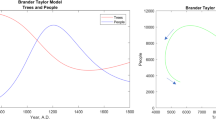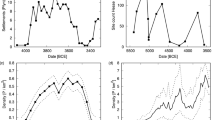Abstract
The Easter Island tragedy has become an allegory for ecological catastrophe and a warning for the future. In the economic literature the collapse is usually attributed to irrational or myopic behavior in the context of a fragile ecosystem. In this paper we propose an alternative story involving non-cooperative bargaining between clans to share the crop. Each clan’s bargaining power depends on its threat level when fighting a war. The biggest group has the highest probability of winning. A clan’s fertility is determined ex ante by each group. In the quest for greater bargaining power, each clan’s optimal size depends on that of the other clan, and a population race follows. This race may exhaust the natural resources and lead to the ultimate collapse of the society. In addition to well-known natural factors, the likelihood of a collapse turns out to be greater when the cost of war is low, the probability of succeeding in war is highly responsive to the number of fighters, and the marginal return to labor is high. We analyze whether these factors can account for the difference between Easter and Tikopia Islands. The paper also makes a methodological contribution in that it is the first fertility model to include strategic complementarities between groups’ fertility decisions.
Similar content being viewed by others
References
Anderies J. M. (2000). On modeling human behavior and institutions in simple ecological economic systems. Ecological Economics 35:393–412
Barro R.J. (1974). Are government bonds net wealth?. Journal of Political Economy 82:1095–1117
Basener B., Ross D. (2005). Booming and crashing populations and easter island. SIAM Journal of Applied Mathematics 65(2):684–701
Binmore K., Rubinstein A., Wolinsky A. (1986). The Nash bargaining solution in economic modelling. Rand Journal of Economics 17(2):176–188
Borrie W.D., Firth R., Spillius J. (1957). The population of Tikopia, 1929 and 1952. Population Studies 10:229–252
Brander J., Taylor M. (1998). The simple economics of easter island: A Ricardo Malthus model of renewable resource use. American Economic Review 88(1):119–138
Clark, G. (2007). In J. Mokyr (Ed.), A farewell to alms—a brief economic history of the world: Princeton and Oxford: Princeton University Press.
Cohen J. (1995). How many people can the earth support. New York, W. W. Norton and Company
D’Alessandro S. (2007). Non-linear dynamics of population and natural resources: The emergence of different patterns of development. Ecological Economics 62(3–4):473–481
Dalton T., Coase R., Badiollah R. (2005). Renewable resources, property-rights regimes and endogenous growth. Ecological Economics 52:31–41
Dalton T., Coats R.M. (2000). Could institutional reform have saved Easter Island? Journal of Evolutionary Economics 10:489–505
Diamond J. (2005). Collapse. how societies choose to fail or survive. New York, Viking Books
Ehrlich I., Lui F.T. (1991). Intergenerational trade, longevity, and economic growth. Journal of Political Economy 99(5):1029–1059
Erickson J., Gowdy J.M. (2000). Resource use, institutions, and sustainability: A tale of two pacific island cultures. Land Economics 76(3):345–354
Firth R. (1936). We, the Tikopia. London, George Allen and Unwin
Firth R. (1967). The work of the gods in Tikopia (2nd ed). New York, Humanities Press
Flenley J., Bahn P. (2003). The enigmas of Easter Island. New York, Oxford University Press
Flenley J., King A., Teller J., Prentice M., Jackson J., Chew C. (1991). The late quaternary vegetational and climatix history of Easter Island. Journal of Quaternary Science 6(2):85–115
Good, D., Reuveny, R. (2007). On the collapse of historical societies. (Paper presented at the Conference of the European Association of Environmental and Resource Economists).
Grossman H.I., Kim M. (1995). Swords or plowshares? A theory of the security of claims to property. Journal of Political Economy 103(6):1275–1288
Hahn F. (1962). The stability of the cournot oligopoly solution. Review of Economic Studies 29(4):329–331
Harford J. (2000). Methods of pricing common property use and some implications for optimal child-bearing and the social discount rate. Resource and Energy Economics 22:103–124
Hirshleifer J. (1991). The technology of conflict as an economic activity. American Economic Review 81(2):130–134
Hirshleifer J. (1995). Anarchy and its breakdown. Journal of Political Economy 103(1):26–52
Keegan J. (1993). A history of warfare. New York, Knopf
Kirch P.V. (1986). Exchange systems and inter-island contact in the transformation of an island society. Island socities: Archaeological approaches to evolution and tranformation. Cambridge, Cambridge University Press
Kirch P.V. (1997). Microcosmic histories: Island perspective on ‘global change’. American Anthropologist 99(1):30–42
Kirch P.V., Yen D. (1982). Tikopia: The prehistory and ecology of a Polynesia outlier. Honolulu, Bishop Museum Press
Ladefoged T., Stevenson C., Vitousek P., Chadwick O. (2005). Soil nutrient depletion and the collapse of Rapa Nui society. Rapa Nui Journal 19(2):100–105
Lagerloef N.-P. (2006). The Galor-Weil model revisited: A quantitative exercise. Review of Economic Dynamics 9:116–142
Lasserre P., Souberyan A. (2003). A Ricardian model of the tragedy of the commons. Journal of Economic Behavior and Organization 50:29–45
Matsumoto A. (2002). Economic dynamic model for small islands. Discrete Dynamics in Nature and Society 7(2):121–132
Maxwell W., Reuveny R. (2005). Continuing conflict. Journal of Economic Behavior and Organization 58:30–52
Münster, J., & Staal, K. (2005). War with outsiders makes peace inside (Discussion Papers No. 75). SFB/TR 15 Governance and the Efficiency of Economic Systems, Free University of Berlin, Humboldt University of Berlin, University of Bonn, University.
Owsley, D., Will, G., & Ousley, S. (1994). Biological effects of european contacts on easter island. In C. M. Stevenson, G. Lee F. Morin (Eds.), Easter island in pacific context: South seas symposium: Proceedings of the fourth international conference on easter island and east polynesia (pp. 129–134).
Page S.E. (2005). Are we collapsing? A review of Jared Diamond’s Collapse: How societies choose to fail or succeed. Journal of Economic Literature 43(4):1049–1062
Pezzey J., Anderies J. (2003). The effect of subsistence on collapse and institutional adaptation in population-resource societies. Journal of Development Economics 72:299–320
Ponting C. (1991). A green history of the world: The environment and the collapse of great civilizations. New York, Penguin
Prskawetz A., Gragnani A., Feichtinger G. (2003). Reconsidering the dynamic interaction of renewable resources and population growth: A focus on long run sustainability. Environmental Modeling and Assessment 8:35–45
Rainbird P. (2002). A message for our future? The Rapa Nui (Easter Island) ecodisaster and Pacific islands environment. World Archaelogy 33(3):436–451
Reuveny R., Decker C. (2000). Easter island: Historical anecdote or warning for the future? Ecological Economics 35:271–287
Reuveny R., Maxwell W. (2001). Conflict and renewable resource. The Journal of Conflict Resolution 45(6):719–742
Rolett B., Diamond J. (2004). Environmental predictors of pre-European deforestation on Pacific islands. Nature 431(7007):443–446
Sahlins M. (1955). Esoteric efflorescence in easter island. American Anthropologist 57(5):1045–1052
Skaperdas S. (1996). Contest success functions. Economic Theory 7(2):283–290
Taylor, R. (1973). An atlas of pacific islands rainfall. Hawaii Inst. Geophysics Data Report No. 25. Univ. Hawaii, Honolulu.
Van Tilburg J.A., Mach J. (1995). Easter island: Archeology, ecology and culture. Washington, D.C.: Smithsonian Institute Press
Author information
Authors and Affiliations
Corresponding author
Rights and permissions
About this article
Cite this article
de la Croix, D., Dottori, D. Easter Island’s collapse: a tale of a population race. J Econ Growth 13, 27–55 (2008). https://doi.org/10.1007/s10887-007-9025-z
Published:
Issue Date:
DOI: https://doi.org/10.1007/s10887-007-9025-z




